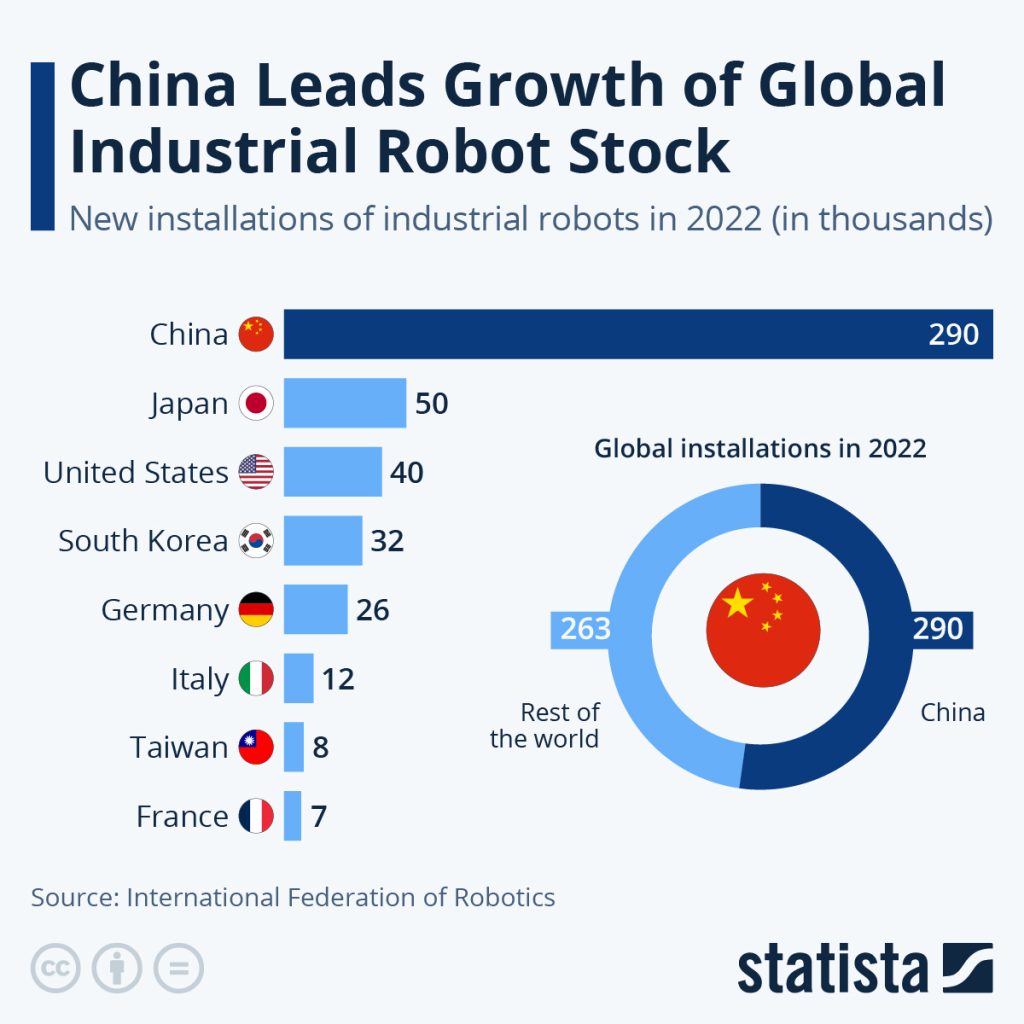
China’s Industrial Robot Production Surges 51.5% in April 2025, Signaling a New Era in Automation
In a significant leap for the robotics industry, China reported a staggering 51.5% year-on-year increase in industrial robot production for April 2025. According to data from the National Bureau of Statistics of China, the country manufactured 71,547 units in a single month, marking its strongest monthly growth in years.
This surge reflects not just a rebound from past slowdowns but a deliberate acceleration in China’s commitment to automation, AI, and smart manufacturing—an area it aims to dominate globally.
Key Drivers Behind the Surge
- Strategic National Initiatives: China’s “Made in China 2025” policy aims to transform the nation into a global manufacturing powerhouse by emphasizing high-tech industries, including robotics. This policy has provided substantial support and incentives for the development and adoption of industrial robots. Wikipedia
- Technological Advancements: Rapid developments in artificial intelligence and machine learning have enhanced the capabilities of industrial robots, making them more adaptable and efficient in various manufacturing processes.
- Labor Market Dynamics: Rising labor costs and an aging workforce have prompted manufacturers to invest in automation to maintain productivity and competitiveness.

Leading Companies in the Robotics Sector
- UBTech Robotics: Founded in 2012, UBTech specializes in humanoid robots and has been at the forefront of integrating AI with robotics. The company’s Walker series robots are designed for various applications, including manufacturing and logistics. ubtrobot.com+1Wikipedia+1
- Unitree Robotics: Established in 2016, Unitree focuses on quadruped robots and has recently ventured into humanoid robots. Their products are known for affordability and versatility, catering to both industrial and consumer markets.
Economic Implications
The surge in industrial robot production reflects China’s broader economic strategy to shift from labor-intensive manufacturing to high-tech industries. This transition is expected to enhance productivity, reduce reliance on human labor, and position China as a leader in global manufacturing innovation.
Moreover, the increased adoption of robotics is anticipated to have ripple effects across various sectors, including logistics, healthcare, and service industries, further solidifying China’s economic resilience amid global challenges.
What’s Driving the Boom?
1. National Strategy: Made in China 2025
China’s industrial robotics expansion is closely tied to its “Made in China 2025” initiative, which promotes high-end manufacturing, robotics, and smart factories. The goal is to reduce dependency on foreign tech and become a global leader in automation.
2. Rapid Advances in AI and Robotics Tech
The integration of AI, machine learning, and deep learning algorithms has dramatically improved robot capabilities. Modern industrial robots can now perform complex tasks with greater precision, adaptability, and autonomy.
3. Labor Challenges and Cost Efficiency
With rising wages and a shrinking labor force in key manufacturing regions, many companies are turning to robots to boost productivity and reduce long-term costs. Automation is no longer just a luxury—it’s a necessity to stay competitive.
China’s Robotics Champions: UBTech and Unitree
Companies like UBTech Robotics and Unitree Robotics are leading the charge.
- UBTech: Known for its humanoid robots, UBTech is expanding into industrial applications by introducing robots for logistics, assembly lines, and service industries.
- Unitree: Famous for its quadruped robots, Unitree is leveraging its designs for use in warehouses, inspection services, and security patrols.
These companies are innovating fast, blurring the lines between industrial and service robotics.
Global Impact and Economic Implications
China has been the world’s largest market for industrial robots for 11 consecutive years, and this growth further solidifies its dominance. But this also raises important questions:
- Will China flood global markets with low-cost, high-function industrial robots?
- How will other manufacturing powerhouses (like Germany, Japan, and the U.S.) respond?
- What will this mean for global labor dynamics?
As China’s influence in robotics grows, so does its ability to reshape global supply chains and manufacturing practices.
What’s Next?
Given the current trajectory, experts predict that China’s annual output could exceed 600,000 units by the end of 2025. Investments are expected to grow, not just in hardware, but also in robotics software, cloud robotics, and AI integration.
Expect more collaboration between private firms and government-backed innovation hubs, as well as increased exports of Chinese-made industrial robots to developing nations eager to automate.
Future Outlook
With continued government support and technological innovation, China’s industrial robot production is poised for sustained growth. Analysts predict that this trend will not only bolster domestic manufacturing capabilities but also expand China’s influence in the global robotics market.
As automation becomes increasingly integral to manufacturing, China’s advancements in industrial robotics are set to redefine global production paradigms and economic structures.
Sources
South China Morning Post – China’s Industrial Robot Output Soars
IndexBox – China’s Robot Production Surges in April
KrAsia – April Industrial Robot Output Growth














Pingback: Intermittent Fasting: Why It’s America’s #1 Diet Trend Today - Everyday Next